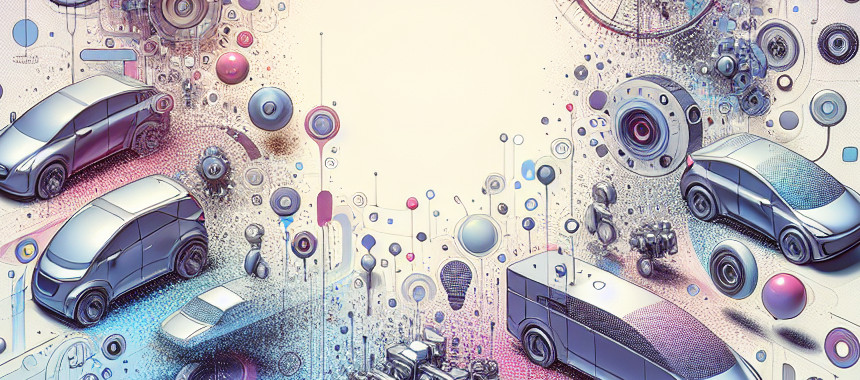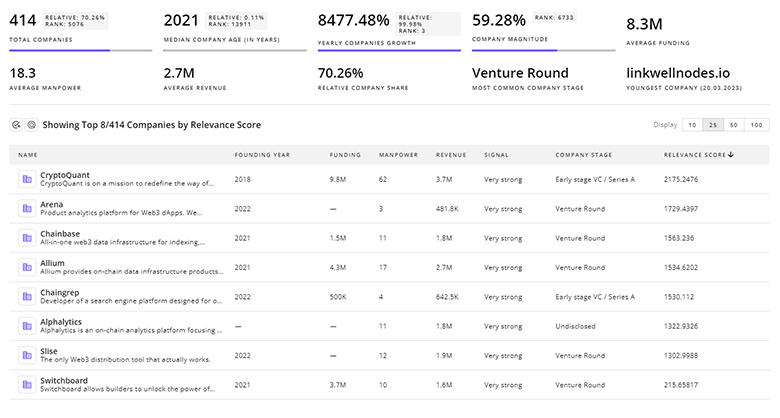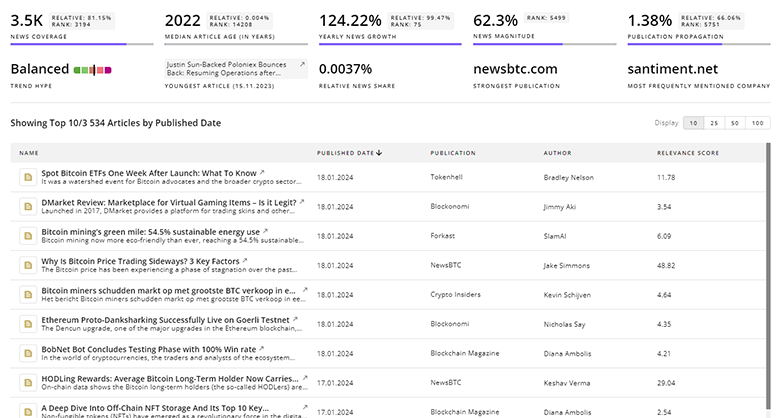
Autonomous Vehicles Report
: Analysis on the Market, Trends, and TechnologiesThe autonomous-vehicle market is expanding quickly, led by a strong market growth rate of 22.0% CAGR in the autonomous-vehicle market (internal trend data), which signals continuing rapid commercialization across logistics, passenger mobility, and niche industrial applications. This expansion rests on three reinforcing forces: (1) falling sensor and component costs that make fleet economics viable at scale (sensor market projections and unit-cost declines), (2) consolidation around full-stack software platforms that centralize perception, planning, and fleet operations, and (3) focused vertical deployments (freight, last-mile delivery, mining, agriculture) that convert pilots into revenue-generating services.
This report was last updated 19 days ago. Spot an error or missing detail? Help us fix it by getting in touch!
Topic Dominance Index of Autonomous Vehicles
To identify the Dominance Index of Autonomous Vehicles in the Trend and Technology ecosystem, we look at 3 different time series: the timeline of published articles, founded companies, and global search.
Key Activities and Applications
Passenger robotaxi and on-demand ride services — Major platform players scale robotaxi pilots into city services; these prove demand curves, produce operational data, and expose software edge cases that force iterative safety validation and regulatory engagement Waymo community Autonomous Vehicles Market Overview 2025.
So what: real-world ride data is the critical asset that converts R&D into deployable route policies and monetizable mobility-as-a-service offerings.Autonomous freight and long-haul trucking — Highway autonomy and platooning reduce driver costs and increase asset utilization; partnerships between AV stacks and truck OEMs target predictable ODDs (highway segments) to accelerate commercial returns Plus.
So what: freight offers a clearer regulatory and operational path to scale because routes are repetitive and easier to certify than complex urban driving.Last-mile and sidewalk delivery robots — Small, electric, zero-occupant vehicles adapt to tightly defined city ODDs and strong retail partnerships; this vertical shows faster unit economics and earlier payback than full passenger robotaxi rollouts Nuro.
Industrial and off-road autonomy (mining, agriculture, construction) — Purpose-built autonomy converts high labor or safety cost environments into early commercial deployments (retrofitting existing vehicles and fleet management systems) AgXeed.
So what: vertical deployments produce predictable data and ROI, creating acquisition targets for OEMs and platform integrators.Mapping, simulation, and validation services — HD maps, synthetic data, and closed-loop simulators shorten validation cycles and reduce on-road miles needed for safety verification CARLA simulator MORAI Inc..
So what: companies that provide realistic scenario generation and high-throughput simulation become essential parts of any scale-up playbook for AV fleets.
Emergent Trends and Core Insights
Sensor-cost and commoditization pressure — Lidar and other sensor costs have collapsed relative to a decade ago, changing hardware economics and enabling sensor-rich consumer and fleet systems (sensor market growth and price declines).
So what: cheaper, automotive-grade sensors shift competition from one-off hardware to software differentiation and supply-chain scale advantages.Platform consolidation around software stacks — Industry momentum favors full-stack, AI-centric platforms that unify perception, planning, and fleet management; OEMs and Tier-1s increasingly partner with or license such stacks rather than build every layer in-house.
Data as strategic moat — Large fleets and ride services generate operational edge-case datasets; companies that capture, label, and iterate on this data improve models far faster than isolated pilots.
So what: small specialists must partner tightly with data holders or risk commoditization.Vertical prioritization and specialized ODDs — Firms targeting mining, agriculture, or fixed logistics routes show earlier commercial traction than general urban autonomy because domain constraints simplify validation.
So what: investors and corporates should evaluate vertical fit and regulatory ease when allocating capital.Cybersecurity and safety assurance intensify — As connectivity grows (V2X, OTA), lifecycle security for fleets becomes a differentiator; vehicle cybersecurity providers and secure-by-design suppliers gain procurement preference AUTOCRYPT.
So what: security provides both risk mitigation and revenue opportunities (SaaS, compliance services).
Technologies and Methodologies
Multi-modal sensor fusion (LiDAR + radar + cameras + thermal) — Improves redundancy and all-weather perception; adoption of 4D/5D radar and solid-state LiDAR is accelerating ADASKY thermal sensors.
So what: sensor fusion reduces single-sensor failure modes and enables safer ODD expansion.End-to-end and modular AI stacks — From deep perception nets to behavior prediction and motion planning, AI architectures now power core decisioning while modular APIs enable integration with legacy vehicle controls.
So what: software modularity reduces integration friction and speeds deployment across OEM partners.Simulation-first validation and synthetic data — Scalable scenario generation shortens validation cycles and exposes rare edge cases without risking road incidents.
So what: simulation suppliers are a leverage point for accelerating regulatory acceptance and reducing validation cost.Edge compute and specialized inference accelerators — Automotive AI SoCs and in-vehicle accelerators (real-time perception & planning) minimize latency and dependency on connectivity.
V2X and GPS-independent localization — C-V2X, SLAM, and visual positioning systems provide resilience in GPS-denied environments and enable cooperative maneuvers such as platooning.
So what: infrastructure coordination reduces the vehicle ODD burden and increases route reliability.
Autonomous Vehicles Funding
A total of 2.7K Autonomous Vehicles companies have received funding.
Overall, Autonomous Vehicles companies have raised $436.2B.
Companies within the Autonomous Vehicles domain have secured capital from 11.0K funding rounds.
The chart shows the funding trendline of Autonomous Vehicles companies over the last 5 years
Autonomous Vehicles Companies
- NODAR — NODAR develops ultra-wide-baseline 3D camera systems that extend perception range and accuracy beyond traditional stereo setups; the firm positions camera-based 3D sensing as a lower-cost alternative to lidar in selected ODDs and industrial applications. NODAR focuses on safety-critical deployments where range and low false positive rates matter, and it targets retrofit and OEM sensor stacks that require compact, automotive-grade solutions.
- Skyline Nav AI Inc. — Skyline builds GPS-independent visual localization (camera-based) that localizes vehicles to decimeter accuracy without external infrastructure; the product targets mining, defense, and GPS-challenged urban canyons where GNSS outages occur. Its positioning approach reduces dependence on high-precision GNSS and complements SLAM/HD map strategies for resilient navigation.
- 51Sim — 51Sim commercializes synthetic-data and simulation tooling (SimOne, DataOne) to generate scenario diversity for embodied AI training; it serves domestic Chinese OEMs and autonomy teams by producing closed-loop, labeled datasets for perception and planning model training. Its emphasis on scale and localized traffic models appeals to fast-moving AV developers that need massive scenario coverage.
- Vilota — Vilota provides visual positioning systems (VPS) tailored to constrained environments such as mines and construction sites, enabling localization where GNSS fails and simplifying integration for autonomy in heavy equipment. The company packages perception and VIO pipelines into modular units to accelerate on-site deployments and to reduce integration time for fleet operators.
Identify and analyze 13.1K innovators and key players in Autonomous Vehicles more easily with this feature.

13.1K Autonomous Vehicles Companies
Discover Autonomous Vehicles Companies, their Funding, Manpower, Revenues, Stages, and much more
Autonomous Vehicles Investors
TrendFeedr’s investors tool offers a detailed view of investment activities that align with specific trends and technologies. This tool features comprehensive data on 11.3K Autonomous Vehicles investors, funding rounds, and investment trends, providing an overview of market dynamics.

11.3K Autonomous Vehicles Investors
Discover Autonomous Vehicles Investors, Funding Rounds, Invested Amounts, and Funding Growth
Autonomous Vehicles News
Stay informed and ahead of the curve with TrendFeedr’s News feature, which provides access to 98.6K Autonomous Vehicles articles. The tool is tailored for professionals seeking to understand the historical trajectory and current momentum of changing market trends.

98.6K Autonomous Vehicles News Articles
Discover Latest Autonomous Vehicles Articles, News Magnitude, Publication Propagation, Yearly Growth, and Strongest Publications
Executive Summary
The autonomous-vehicle market sits at an inflection point where falling sensor costs, stronger AI stacks, and disciplined vertical plays convert experimental pilots into commercial services. The immediate commercial winners will be those that (1) secure access to differentiated operational data, (2) integrate into full-stack platforms or become indispensable, tightly integrated components, and (3) align deployment plans to narrowly defined operational design domains that yield predictable economics (freight corridors, last-mile delivery, and industrial sites). For corporates and investors the priority is clear: back platform interoperability, bolster data pipelines and simulation capacity, and prioritize cybersecurity and regulatory engagement to move from pilot to profitable scale.
Interested in enhancing our coverage of trends and tech? We value insights from experts like you - reach out!













